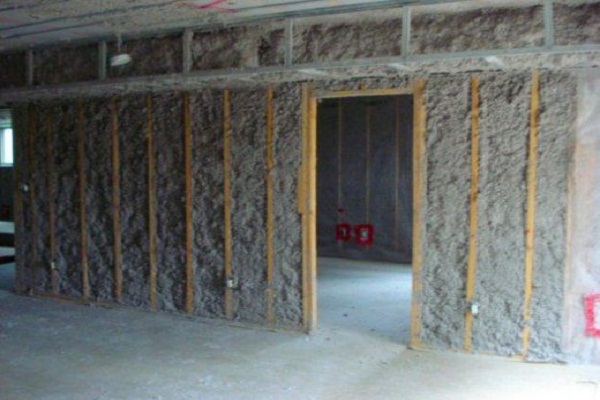A joint venture between graphene specialists at The University of Manchester and alumni-led construction firm Nationwide Engineering has developed a product that could revolutionise the concrete industry and its impact on the environment.
Located a couple of miles east of the ancient monument of Stonehenge, the new Southern Quarter gym in Amesbury’s Solstice Park – owned and run by military veterans and due to open in summer 2021 – is the site for the innovative build, made possible by a joint venture between Nationwide Engineering and The University of Manchester.
Production of cement for concrete in the building industry is one of the leading causes of global carbon dioxide emissions. Statistically speaking, if concrete were a country, it would be the third largest emitter in the world behind only China and the US, producing around 8 per cent of global CO2 emissions.
The addition of tiny amounts of graphene – a so-called ‘2D material’ made of a single layer of carbon atoms – strengthens Nationwide Engineering’s new product, Concretene, by around 30 per cent compared to standard concrete, meaning significantly less is needed to achieve the equivalent structural performance, reducing carbon footprint and costs.
The additional strength also reduces the need for steel reinforcement, saving material and time on site and further promoting the green credentials of this building method.
Nationwide Engineering estimates that an additional cost of 5 per cent for Concretene will be offset by the reduction in material to deliver an overall saving of 10-20 per cent over standard RC30 concrete.
“We are thrilled to have developed and constructed this game-changing, graphene-enhanced concrete on a real project,” said Alex McDermott, co-founder and managing director of Nationwide Engineering. “Together with our partners at The University of Manchester’s Graphene Engineering Innovation Centre and structural engineers HBPW Consulting, we are rapidly evolving our knowledge and experience and are positioned for wider industry deployment through our construction frameworks, becoming the go-to company for graphene-enhanced concrete.”
Nationwide Engineering has three existing five-year construction frameworks with Network Rail and two seven-year Government Crown commercial building frameworks. With Network Rail committing to an 11 per cent reduction in CO2 emissions over the next four years, graphene-enhanced concrete shows significant potential to help meet this target.
Traditional liquid concrete sets into its solid form through chemical reactions known as hydration and gelation, where the water and cement in the mixture react to form a paste that dries and hardens over time.
Graphene makes a difference by acting as a mechanical support and as a catalyst surface for the initial hydration reaction, leading to better bonding at microscopic scale and giving the finished product improved strength, durability and corrosion resistance.
Dr Craig Dawson, application manager at the Graphene Engineering Innovation Centre, explained: “We have produced a graphene-based additive mixture that is non-disruptive at the point of use. That means we can dose our additive directly at the batching plant where the concrete is being produced as part of their existing system, so there’s no change to production or to the construction guys laying the floor.
“We have been able to do this via thorough investigation – alongside our University colleagues from the Department of Mechanical, Aerospace and Civil Engineering – of the materials we are using and we can tailor this approach to use any supplier’s graphene, so we are not beholden to a single supplier,” he added. “This makes Concretene a more viable proposition as there is increased security of supply.”
At the Amesbury site, an initial pour of 234m2 of Concretene was conducted on May 6, with a further 495m2 laid on May 25 to complete the concrete floor slab. The graphene used for the latter pour was supplied by Versarien plc.
Nationwide Engineering will manage and monitor the site during its fit-out and onward operation, effectively creating a ‘living laboratory’ at Southern Quarter to measure and evaluate the performance of the material.
The Graphene Engineering Innovation Centre is a £60m facility at the University of Manchester, opened in 2018 and dedicated to the commercialisation of graphene and other advanced materials.
Graphene was first isolated at the University in 2004 by two Russian scientists – Andre Geim and Kostya Novoselov – who subsequently won the Nobel Prize for Physics in 2010 for their work on this new material.
Apart from being incredibly strong, graphene is also flexible, see-through and highly thermally and electrically conductive, leading to numerous technological and engineering applications, from anti-corrosion coatings and advanced telecoms to new treatments for cancer.
Graphene holds tremendous promise for reducing the environmental impact of heavy industries such as construction, with concrete a particular focus for researchers. Scientists at Rice University, Texas, US, recently demonstrated a process to convert waste from old rubber tyres into graphene which can, in turn, be used to strengthen concrete.
In related news earlier this week, the Environment Agency announced that low-carbon concrete would now be used for flood defences as part of the wider government plan to ‘build back greener’. EA claimed the move would help reduce emissions by 45 per cent as part of its aim to hit net zero by 2030.
Source: E&T










